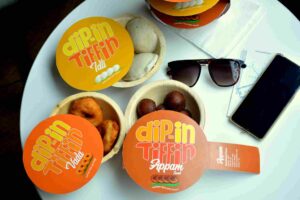Inspired by India’s Lunch ‘Dabba’, Woman Designs Eco Friendly Takeaway Packaging
Product designer Srishti Garg has created the ‘Dip-In Tiffin’, an eco-friendly and on-the-go packaging solution inspired by the stackable Indian tiffin carrier.

Come lunchtime at the office, and everyone pulls out the all-too-familiar stacked dabbas, each tier containing a delightful feast. For years now, these stacked Indian steel dabbas have become synonymous with mealtime. From office goers to school children, they span across age groups and have now become an important part of daily routine.
This very thought served as motivation for Srishti Garg, a project designer to come up with an idea that could turn the tiffin into an eco-friendly design that still served the purpose of transporting food.
The Dip‐in Tiffin borrows inspiration from the popular stacked dabba and is aimed to eliminate single‐use food packaging by restaurants. By opting for this three-tiered eco-friendly design, people will not only receive their food in natural packaging, but it will also contribute to less waste, due to the material that has been used.
“The point of making this design with areca leaf bowls was for it to be disposable and eco-friendly. It would be a great fit for travellers as they would not have to then deal with the intricacies of time and space to take it back home for reusing it,” says Srishti.
Speaking to The Better India, she says it all happened in 2018.
“I was part of a course at college which delved into the purview of how brand languages work. We were supposed to design packaging for food brands that sold breakfast. I wanted to stay true to my cultural roots and give people something that they’d associate with Indian culture. What better than the dabba?”
A design that infuses sustainability with tradition
Wanting to stick to minimalism, Srishti chose a material that would be easily recyclable as well as provide employment to many involved in the production process.
Donne was the ideal fit.
Srishti describes this by saying it is a kind of soup bowl made out of the areca leaf. “The material is easily available and perishable too.” A win-win for the planet.
Once the material was decided upon, the next aspect was design. “I had a stackable structure in mind as I did not want to bring in the complexity of extra packaging. In addition to this, adding tiers would only increase the cost, and I wanted the tiffin to be a solution that is friendly for the pocket,” says Srishti.

Moreover, she says “People are not always comfortable with new interactions,” emphasising her approach to draw from existing semantics and create a design that would be a replica of the dabbawalas of Mumbai.
The process involved playing around with different thicknesses of paper. For her trial foods, she decided to go with idli, vada and appam. Listing the most unique aspects of her design, she points to versatility and simplicity. “One can either make use of one tiffin, or the entire stack depending upon how many items they wish to carry.”
In her opinion, while venturing towards sustainability, we usually go for available designs and lose the meaning in the process. “People are reminded of their Indian roots with my design. The material is an entire industry in itself that is generating employment for so many people in south India. There are craftsmen in these areas who play a prime role. Thus, my design ensures that it does not deconstruct the ecosystem.”
While Srishti’s design is still a prototype, she plans to discuss the concept further with food chains and delivery partners who might have to add to how the design can be made more user-friendly.
“Currently I am looking out. Rather than going in for a final structure, I want to understand what more people would appreciate, and what food chains would also find more versatile. I’m open to developing this design and coming to a consensus where it is a win-win for both parties,” she explains.
While the eco-friendly tiffin is wonderful for dry snack companies, Srishti notes that brands that work with wet foods would prefer a design that incorporates gravy items too. Hence, the development process is on.
From a temperature standpoint, the tiffin will work well in her opinion. “Keeping the tiffin in the fridge will not be an issue, neither will heat.” She supports this claim by speaking of how the areca leaf and containers built from it have been used for rasam, sambhar, etc. without a problem.
“The packaging takes around 90 to 100 days to decompose, similar to paper packaging.”
If you found our stories insightful, informative, or even just enjoyable, we invite you to consider making a voluntary payment to support the work we do at The Better India. Your contribution helps us continue producing quality content that educates, inspires, and drives positive change.
Choose one of the payment options below for your contribution-
By paying for the stories you value, you directly contribute to sustaining our efforts focused on making a difference in the world. Together, let’s ensure that impactful stories continue to be told and shared, enriching lives and communities alike.
Thank you for your support. Here are some frequently asked questions you might find helpful to know why you are contributing?


This story made me
-
97
-
121
-
89
-
167













